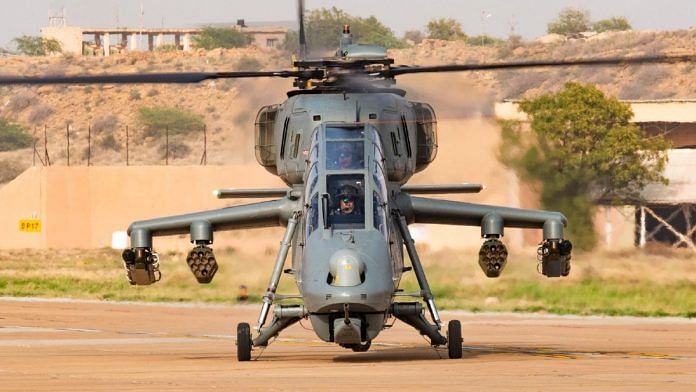A little more than a decade after its inaugural flight, the Hindustan Aeronautics Limited- designed and manufactured Light Combat Helicopter has been inducted in the Jodhpur- based 143 Helicopter Unit of the Indian Air Force. Christened Prachanda, the fiery sounding LCH had earlier been ‘handed’ over to the IAF in November 2021, in Jhansi, Uttar Pradesh. While the LCH was ‘handed’ over to the IAF by the Prime Minister, the induction ceremony at Jodhpur was presided over by the defence minister.
The dual programme to hand over/induct the LCH into India’s military still doesn’t answer the oldest debate haunting attack helicopters – who owns the machine? In the annals of military aviation, this dispute has seen its longest running episode in India. The Army and the Air Force have fought over the ownership of attack helicopters since the venerable Mi-25 Akbar was first inducted into the IAF in 1984. Unlike other countries where the debate has long been settled, in India this duality of ownership continues without an end in sight. The orders placed for Prachanda are testimony to this duality.
Attack helicopters and their ‘positioning’
The Cabinet Committee on Security sanctioned the purchase of 15 LCH on 30 March 2022, and inexplicably, ten of these would be for the IAF and five for the Army. Being the Limited Series Production version, the LCH Prachanda can’t quite live up to its fiery name as it lacks critical weapons and protection systems. There is yet time before it can be fully geared up for fulfilling its operational requirements, and match the threat carried in its name. Still plenty of time to address the question persisting in military aviation circles – what is the purpose of operations for attack helicopters, nature of their deployment and ultimately issues connected to command and control. For the genesis of the dispute is essentially about how attack helicopters are to be deployed.
An absence of codified war-fighting doctrines covering all spectrum operations has meant adhocism over combat platform purchases has persisted over the decades. The prime example, of course, being the purchase of Su-30s when the IAF didn’t have a doctrine, and certainly not one for dual-seater combat aircraft. When the shortage of pilots is endemic, tying down two into one aircraft defied logic, and still does despite the capabilities of the aircraft. The lack of awareness at the executive level perpetuates such decision making, and the LCH is yet another manifestation of that ignorance. It isn’t simply about the ownership being divided two-to-one but understanding the essence of attack helicopter operations.
The evolution of the helicopter is a result of Army leadership’s persistence on getting a close air support platform for soldiers fighting on the ground. Combat fixed-wing aircraft, with higher speeds, and limited time over target held little value for those with their boots on the ground. That support roles performed by helicopters gradually developed into making armed versions. And as the nature of combat changed, with the result that war fighting-doctrines evolved, even combat and assault variants came to be deployed. Over time, they came to be known as anything from flying tanks to gunships, such being their utility for ground operations.
Also read: Border crisis, no NSS, no reforms. But Modi govt is going after imagined colonial demons
The Army’s case
Over three continents, that old Mi-25 has destroyed tanks and other high-value targets. It is also able to insert eight soldiers, for example. This versatility of roles has ensured that the Army leadership sticks to its insistence on the ownership of these platforms.
Since close air support is lower on the Air Force pegging order of operational tasks, worldwide, armies have wrested ownership of combat helicopters to support their troops. The underlying motive being that troops on the move need dedicated air cover that can take out armoured vehicles as well pill boxes and other fortifications. That confidence in the dedicated air cover comes from the same colour of uniform and shape of flying wings. Hence the distribution of 15 LCH defies military logic and sense. Just as they tussled over the Apache purchase earlier, the two services face the same debating points this time around as well.
The only fixed-wing aircraft that has matched, or bettered, an attack helicopter in destroying tanks and other targets on ground during combat has been the A-10 during the first Gulf War. That was terrain similar to what India is likely to face, if it ever enters into a conventional conflict. There is no aircraft of its utility in any Air Force anywhere in the world, but it is slow, ugly, and heavy because of its armour plating. But it has no takers in India, because of the fixation with air superiority. Army planners are wont to say that the ultimate underwriter of air superiority is your own soldier occupying the enemy airfield.
Manvendra Singh is a Congress leader, Editor-in-Chief of Defence & Security Alert and Chairman, Soldier Welfare Advisory Committee, Rajasthan. He tweets @ManvendraJasol. Views are personal.
(Edited by Anurag Chaubey)



